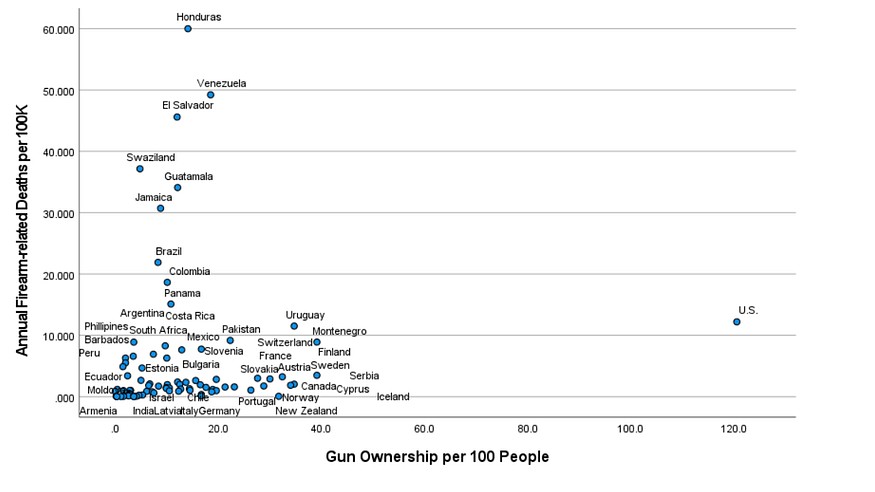By Kent R. Kroeger (Source: NuQum.com, June 14, 2022)
[Data used in this essay can be downloaded from GITHUB.]
Last month’s Buffalo supermarket and Uvalde (Texas) Elementary School massacres that killed 31 people in total has rekindled what is now a recurring ritual in our country: Democrats lamenting that substantive gun control legislation is sorely needed, and Republicans expressing their sympathy for the victims and their families while simultaneously lamenting that Democrat-supported gun control legislation will not significantly reduce gun violence.
Sadly, the public dialogue in the aftermath of these human atrocities has more in common with performance art than it does with legitimate policy debate.
Yet, there is a reason to be optimistic that actual gun control legislation will be passed by the U.S. Congress this year.
This week a group of U.S. Senators, including ten Republicans, announced it had arrived at a tentative proposal to pass the most substantive gun control measures since the Bill Clinton administration. The U.S. House has already approved gun regulation measures — though it is unlikely that bill in its current form will ever pass the U.S. Senate.
While the legislative details on the Senate bill have not been finalized, the general agreement is that it will include:
- financial incentives for states to pass “red flag” laws designed to prevent dangerous individuals from purchasing firearms,
- money for school safety and mental health programs,
- tougher background checks for gun buyers under age 21, and
- restricting people from buying weapons for people who cannot pass a background check.
For the eventual bill to pass the U.S. it will require the support of ten GOP senators.
Assuming the bill passes both chambers and receives President Biden’s signature — and that is strong assumption — is there any reason to expect a significant firearm-related deaths?
Why is it so hard to pass stricter gun control laws in the U.S.?
It was 1994 when the U.S. Congress last passed substantive gun control legislation (the Public Safety and Recreational Firearms Use Protection Act). The law expired in 2004 and its effectiveness remains the subject of debate.
Yet, it baffles many of us as to why the U.S. fails to pass laws that materially restrict the ownership of semi-automatic firearms with high-capacity magazines, which are typically the weapons used in mass shootings. OK, you can keep your handguns and hunting rifles — but who really needs a semi-automatic rifle like an AR-15 that, when modified by a bump stock, can fire 400 rounds per minute?
But there are, in fact, passionate arguments opposing restrictions on semi-automatic firearm sales, ranging from:
- ownership of these firearms are constitutionally-protected,
- the fear that criminals will still find ways to obtain these weapons, while law-abiding citizens will be the ones denied access to them,
- these types of firearms are necessary to protect ourselves from government tyranny.
The last argument generally inspires derision from gun control advocates: Do guardians of the Second Amendment honestly believe 10-rounds of ammunition in their rifle’s magazine will stand between them and the U.S. government?
Yes, in fact, there are thoughtful, highly-educated people who believe ‘tyranny prevention’ is at the core of the Second Amendment’s importance.
If the (Second Amendment’s) core is limited to “self-defense in the home,” then it may be reasonable to conclude that military weapons of all kinds are excluded from protection. If the core purpose is merely “self-defense,” then it may be reasonable to conclude that something more than a handgun is protected. And if the core includes “tyranny prevention” (whether because “self-defense” includes “self-defense from tyranny” or because the core is later defined by the Supreme Court to include it), then some quantum of military weaponry must be protected.
But why are so many gun-rights advocates so absolutist in their defense of the Second Amendment that they won’t even entertain the most modest of gun reforms, such as passing gun registration laws? I can’t legally drive drive a car without it being registered — so why is it acceptable to own an AR-15 rifle without a similar registration requirement? [One answer is that car ownership is not a constitutionally-protected right.]
Nonetheless, it disheartening to many that the U.S. Congress is incapable of passing any kind of bipartisan gun control legislation. Are we that divided as a society? [Yes.]
According to the Gallup Poll, support within the U.S. for stricter gun control laws declined between 1981 and 2021 (going from 78 percent to 52 percent), even as gun ownership has been relatively stable (42 percent in 2021).
Some want to blame the power of the National Rifle Association (NRA) as one of the fundamental barriers to gun control reform. But it is hard to believe that the NRA spending $54.4 million on 2016 federal elections and $29.4 million in 2020 was enough to squash any chance of the U.S. Congress passing impactful gun control legislation. In total, $6.5 billion was spent on federal elections in 2016 and $14.4 billion in 2020. NRA money is a spit in the electoral ocean.
Even red-flag laws in which individuals with a known history of mental illness are restricted from gun ownership meet stiff opposition. If our societal goal is to get meaningful help for the mentally ill, it is fair to ask how such laws will work in the real world. Will people be less likely to seek mental health care if there is a chance they will lose their privacy and a constitutionally-protected right in the process?
There are no easy answers to gun violence in the U.S., particularly when violence is such an integral part of our popular culture and common heritage.
A Cross-National Analysis of Firearm-related Deaths per Capita
Across a varied range of research studies, three variables (what I call the three “pillars” of gun violence) have commonly been found to impact firearm-related deaths in the U.S.:
- The widespread availability of firearms (Americans own 390 million firearms)
- Relatively permissive gun control laws underpinned by a constitutional amendment protecting gun ownership (and which may be the most daunting hurdle facing future attempts at major gun control legislation)
- A national culture that routinely rationalizes violence as a defensible means of conflict resolution.
In this data essay, I use cross-national data on gun laws, gun ownership levels, and attitudes towards violence to demonstrate their possible relationship to firearm-related deaths.
I entered into this specific analysis open to the possibility that gun control laws are generally ineffective. At first, I was going to analyze U.S. state-level data, but it became clear that spillover effects (e.g., the ease with which guns can cross state limit) mute the impact of state-level gun control policies. Besides, I believe a key factor in explaining gun-related deaths is culture — that is, in some countries, people are more open to using violence to solve interpersonal problems and that such violence is sometimes carried out using firearms.
This analytic question led me to do a cross-national analysis, as there is considerable attitudinal data from the World Values Survey on a national population’s openness to using violence for conflict resolution.
Therefore, I constructed a cross-national model explaining annual gun-related deaths per 100K people, using data obtained from the World Population Review and supplemented by data from gunpolicy.org, that included the following variables as explanatory factors (i.e., the three pillars of gun violence):
- a nation’s mean score on a 2017–2020 World Values Survey question asking whether the respondent believed violence against other people was sometimes justified (i.e., the culture of violence),
- the number of firearms per 100 people, using data from the World Population Review,
- and a Gun Policy Index (GPI) constructed from a summary of national gun laws.
[It should be noted that the number of firearm-related deaths per capita included suicides, which typically account for a large percentage of firearm-related deaths.]
The GPI summarizes national laws related to the types of firearms permitted (long guns, handguns, semi-automatic rifles, and fully-automatic firearms) and the existence of gun registration requirements.
Forty countries were initially analyzed; however, four countries — Venezuela, Guatemala, Brazil, and Colombia — were determined to be extreme outliers and excluded from the bivariate charts (Figures 2–4) and the final regression model (Figure 5) reported in the next section.
The factors making Venezuela, Guatemala, Brazil and Colombia dramatically different from other countries — especially, income inequality and ineffectual law enforcement/judicial institutions — should, ideally, be included in the statistical model. However, my initial attempts to include these factors did not remedy the outlier problem. Therefore, I deleted the four outlier countries from the following analysis. Charts and regressions using the outlier cases can nonetheless be found in the Appendix at the end of this essay.
The Results
Social commentators from The Hill’s Briahna Joy Gray to HBO’s Bill Maher are increasingly vocal about the need to change American culture if we want to change the incidence of gun violence. In other words, is our culture driving gun policy?
Maher has been particularly pointed in his criticism of the American entertainment industry:
“The average American kid sees 200, 000 acts of violence on screens before the age of 18 and, according to the FBI, one of the warning signs of a potential school shooter is a fascination with violence-filled entertainment.
It’s funny, Hollywood is the wokest place on earth in every other area of social responsibility, but when it comes to the unbridled romanticization of gun violence…crickets.”
Hollywood feeds the world violent content because it attracts audiences. It’s not complicated.
And this attraction to violence extends beyond entertainment, it continues into our interpersonal relationships. Despite significant public support in the U.S. for stricter gun laws, Americans are more likely than people in other countries to believe violence against others is at least occasionally justified.
According to Wave 7 of the World Values Survey (conducted from 2017 to 2020 in 59 countries), 44 percent of Americans believe ‘violence against other people’ is sometimes justifiable, compared to 33 percent worldwide. Among the 59 countries where the question was asked (see question text below), the U.S. ranked 14th in the percentage of respondents who believe violence against others is sometimes justified (see Figure 1a).
World Value Survey item:
Q191: On a 10-point scale from 1 to 10, please tell me…whether you think ‘violence against other people’ can always be justified (10), never be justified (1), or something in between.
Figure 1a: The percentage of respondents who believe violence against others is sometimes justifiable (Top 20)

The Top 20 countries for justifiable violence is an eclectic mix, ranging from Tajikistan, where 78 percent believe violence against others is sometimes justifiable!, to Guatemala at 36 percent. However, there appears to be some regional clustering in this attitude prevalence — namely, North America (Canada, Mexico, and U.S.), Southeast Asia (Vietnam, Philippines, and Malaysia) and East Asia (Mongolia, South Korea, Macau, and Hong Kong).
There are no West European countries in the Top 20.
When viewing the countries with the lowest percentage of people who believe violence against others is sometimes justifiable, geographic clustering is not as apparent (see Figure 1b).
Figure 1b: The percentage of respondents who believe violence against others is sometimes justifiable (Bottom 20)
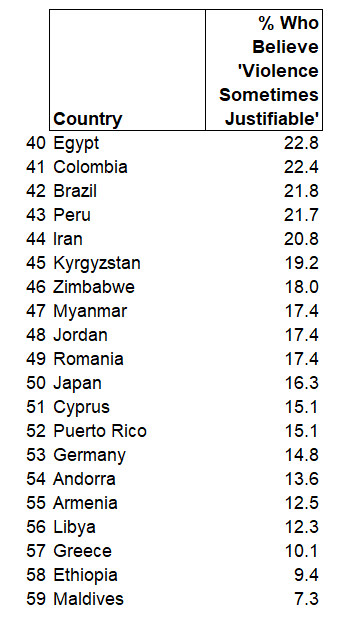
But the important question is, do attitudes towards violence correlate with objective gun violence measures, particularly the annual number of firearm-related deaths per capita?
Based on Figure 2 (below), the answer appears to be yes, at least when outlier countries — Brazil, Colombia, Guatemala, and Venezuela — are removed from the analysis (see Figure A4 in the Appendix for comparison). In general, countries with a relatively high percentage of citizens who believe violence is sometimes justifiable tend to have higher firearm-related death rates.
Figure 2: A bivariate scatterplot of firearm-related deaths per capita by the mean World Values Survey score (Q191) for the justifiability of violence against other people (excludes outlier countries)
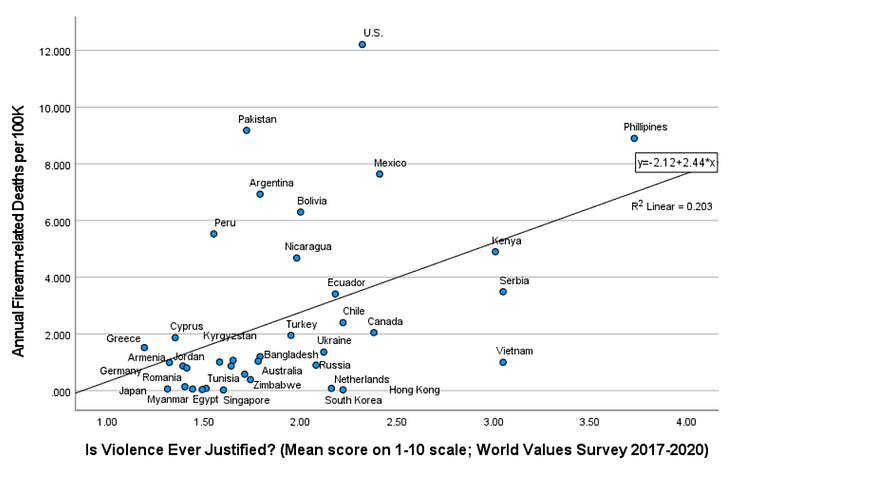
We have tentative evidence that the first pillar of gun violence — a nation’s culture of violence — is potentially significant.
What about the second pillar — the availability of firearms?
In the bivariate case, the number of firearms per capita also appears to have a positive relationship to firearm-related deaths per capita (see Figure 3).
Figure 3: A bivariate scatterplot of firearm-related deaths per capita by the the number of firearms owned per 100 people (excludes outlier countries)
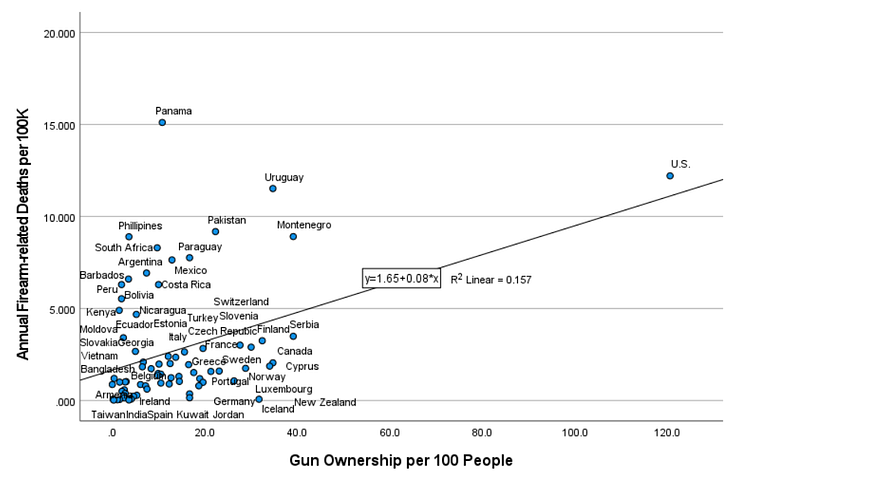
The U.S. position in Figure 3 is striking. The country has, by far, the highest level of gun ownership in the world and is second in firearm-related deaths per capita.
Finally, we have the third pillar of gun violence — national gun control laws and policies.
In the cross-national context, does variation in gun control laws and policies relate to differences in gun violence?
Again, the answer appears to be yes. More restrictive gun control policies are associated with fewer firearm-related deaths per capita.
Figure 4: A bivariate scatterplot of firearm-related deaths per capita by the Gun Policy Index (excludes outlier countries)
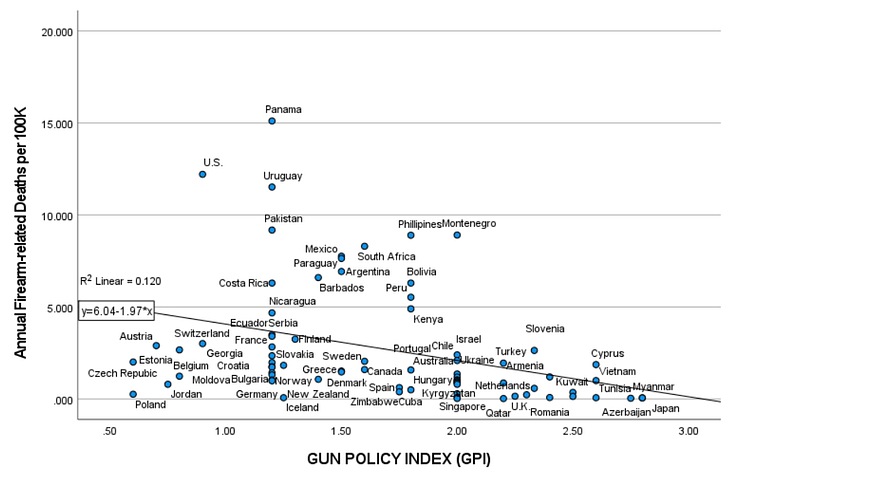
The next step is to see if these three pillars of gun violence — culture, gun availability, and gun laws — are independently related to firearm-related deaths per capita when all three factors are included in a single statistical model.
According to the linear model estimates reported in Figure 5, the answer is a solid yes. Overall, the three variable model accounts for 45 percent of the cross-national variance in firearm-related deaths per capita with all three variables achieving statistically significant parameters estimates with p-values less than the significance level (α = 0.05).
Figure 5: A linear model of firearm-related deaths per 100K people (excludes outlier countries)
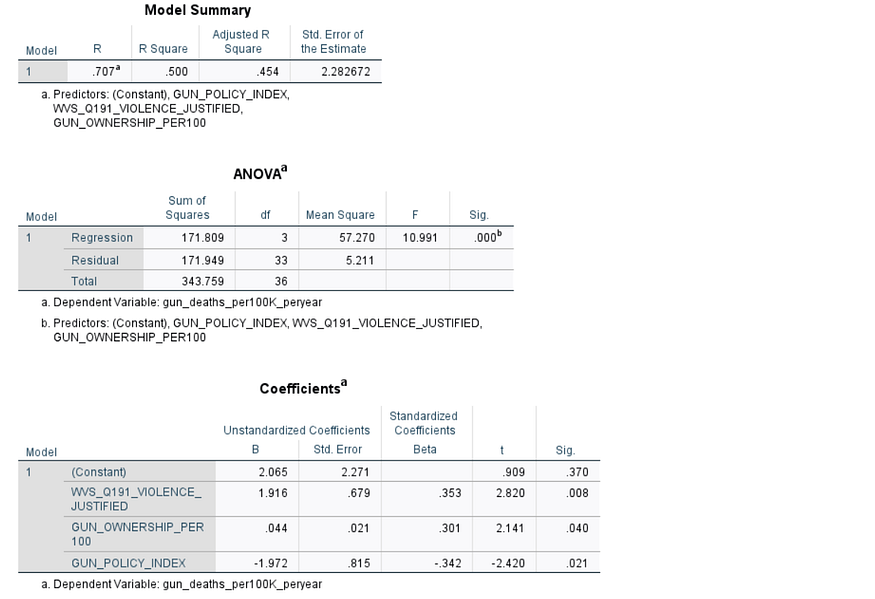
Interpretation of standardized coefficients (Betas):
A change of one standard deviation in the a nation’s mean attitude-levels towards violence is associated with a change 0.35 standard deviations in the number of firearm-related deaths per capita.
A change of one standard deviation in the a nation’s gun ownership rates per 100 people is associated with a change 0.30 standard deviations in the number of firearm-related deaths per capita.
A change of one standard deviation in the a nation’s score on the Gun Policy Index (high values indicate stricter gun laws) is associated with a change -0.34 standard deviations in the number of firearm-related deaths per capita.
The unstandardized coefficient for gun ownership rates per capita (b = 0.044) is also interesting as it has implications for one particular gun control policy: buy-back laws in which a country lowers gun ownership rates by buying guns from its citizens.
If the U.S. government spent $30 billion to buyback 60 million guns (@ $500 per gun), that might lead to 3,000 fewer gun-related deaths each year in the U.S. — which is almost 7 percent of annual firearm-related deaths currently (i.e., 45,000 in 2021).
The model in Figure 5 is not proof of causation — it merely suggests the possibility that these variables are related in a cross-national context. We cannot rule out the possibility that gun violence drives culture, or similarly, that levels of gun violence drive gun laws and gun ownership levels. All directions of causation are on the table.
However, informed by this analysis, I am now more inclined to conclude that culture, gun availability, and gun laws are related to gun violence.
Final Thoughts
In his 2002 documentary, Bowling for Columbine, filmmaker Michael Moore posed an interesting question: Why does Canada experience significantly fewer gun-related deaths than the U.S., despite having a comparable gun ownership rate.
In reality, Canada does not have a gun ownership rate comparable to the U.S. (34.7 guns per 100 people versus 120 guns per 100 people). Nonetheless, Canada has significantly fewer gun-related deaths per capita than the U.S. (2.05 deaths per 100K versus 12.2 deaths per 100K).
Moore doesn’t offer an explicit explanation for this difference in his film, but he does leave his audience with an implicit one: The higher U.S. firearm-related death rate compared to other countries is, at least partially, the result of a more violent culture.
This data essay confirms that conclusion: Culture is a powerful driver of gun violence. When citizens believe violence is sometimes an acceptable approach for solving interpersonal problems, the probability that guns will be involved also increases.
We live in a country that fetishizes violence from its foreign policies to popular entertainment choices, and our perennial defense of gun ownership is just one manifestation of this seemingly irreversible cultural trait.
Independent of the importance of gun laws and the prevalence of guns in explaining gun-related deaths, culture stands as an equally important factor.
That said, my cross-national analysis suggests stricter gun laws and a incentivized reduction in gun ownership could lead to a substantial decrease in gun-related deaths.
The Second Amendment will always protect against political attempts at stricter gun laws, but there is no constitutional impediment to a gun buyback policy.
Would you have our government spend $30 billion to buyback 60 million guns (@ $500 per gun) if that, in turn, might lead to 3,000 fewer gun-related deaths each year?
I would.
- K.R.K.
Send comments to: kroeger98@yahoo.com
Appendix — Alternative Models and Graphs
Figure A1: A linear model of firearm-related deaths per 100K people (includes outlier countries)
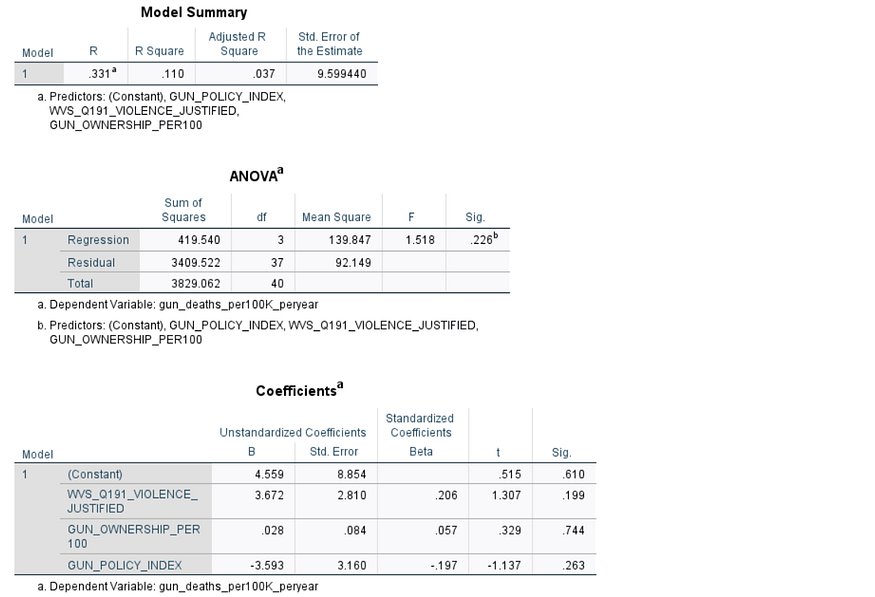
Figure A2: A linear model of firearm-related deaths per 100K people (using an indicator variable for outlier countries)
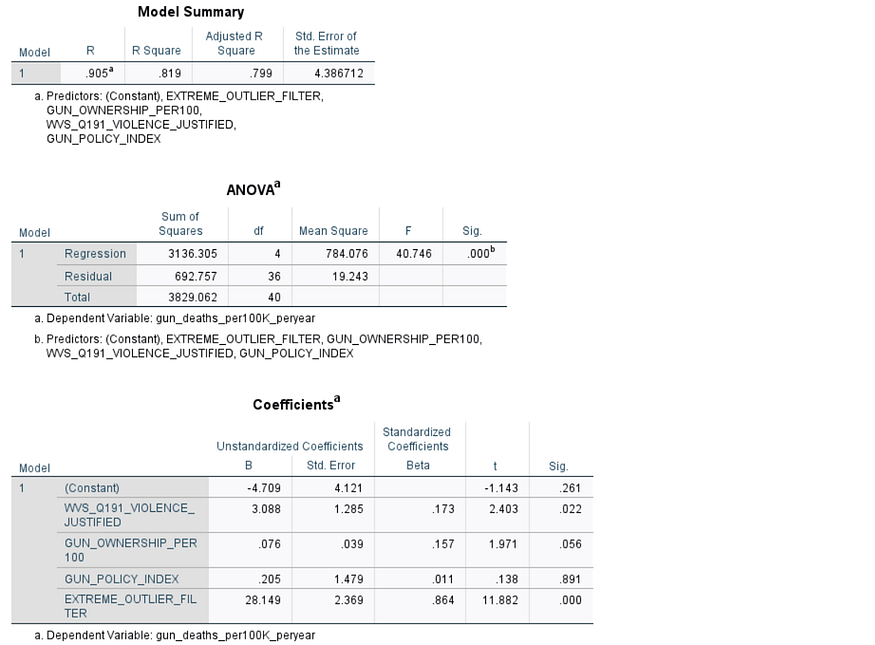
Figure A3: A bivariate scatterplot of firearm-related deaths per capita by the Gun Policy Index (includes outlier countries)
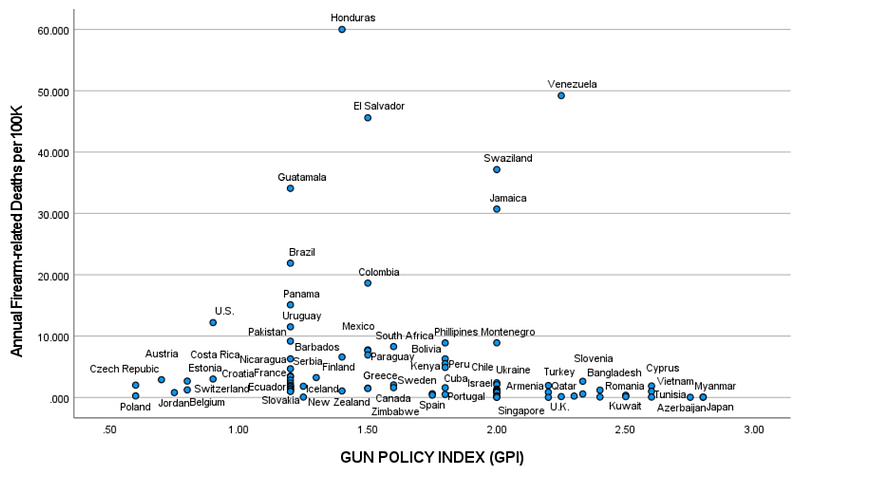
Figure A4: A bivariate scatterplot of firearm-related deaths per capita by the mean World Values Survey score (Q191) for the justifiability of violence against other people (includes outlier countries)
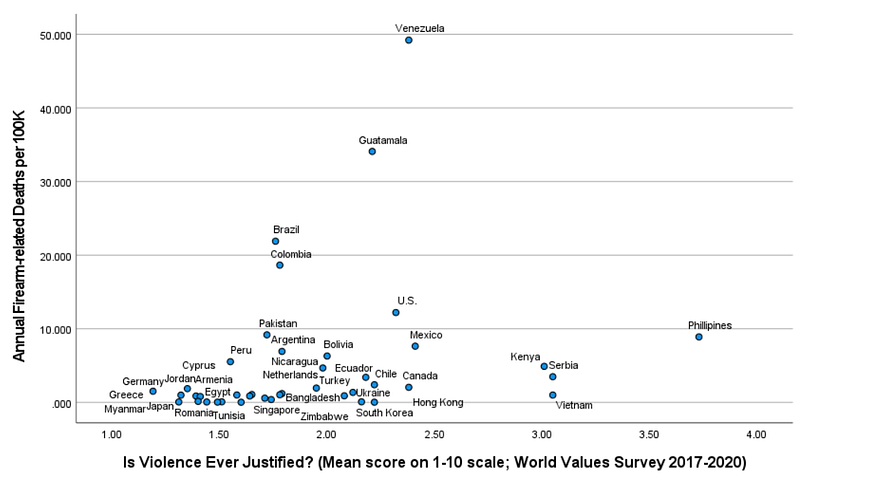
Figure A5: A bivariate scatterplot of firearm-related deaths per capita by the the number of firearms owned per 100 people (includes outlier countries)
